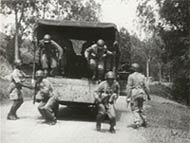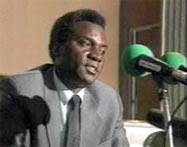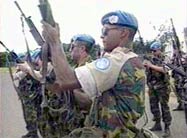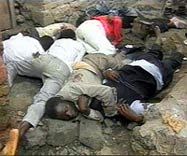CHRONOLOGY OF A GENOCIDE
Timeline of Events in Rwanda
15th Century — "Kingdom" of Rwanda takes shape as a feudal society with the general social division between farmers (Hutu) and more powerful cattle herders (Tutsi).
Late 1800s — Tutsi King Kigeri Rwabugiri establishes a unified state with a centralized military structure.
1885 — The Berlin Conference divides the African continent and "gives" the region of Rwanda to Germany.
(Map of Berlin Conference)

Rwanda in the 1890s during colonization. Photo: Amnesty International Film Forgotten Cries |
1890 — The Ruanda-Urundi region (now Rwanda and Burundi) becomes part of German East Africa.
1894 — German East African Governor Count Gustav Adolf von Gotzen visits the royal court.
1916 — During WWI, Allies capture German East Africa. Belgian troops occupy the area.
1923 — League of Nations grants Belgium a mandate to govern Ruanda-Urundi, which it rules indirectly through Tutsi kings.
1933 — Belgian census classifies population by ethnicity based on height, shape of nose and eyes. Identity cards issued to Tutsi, Hutu and Twa groups.

A Belgian-run school in Rwanda. Photo: Amnesty International Film Forgotten Cries |
1945 — Raphael Lemkin coins the term "genocide" after reading about mass killings in Armenia. Lemkin served as adviser on foreign affairs to the U.S. War Department and was on the staff of the U. S. Chief of Counsel for Prosecution of Criminality at Nuremberg.
1946 — Ruanda-Urundi becomes UN trust territory governed by Belgium.
December 11, 1946 — The United Nations General Assembly declares genocide a crime under international law.
1957 — Hutus issue manifesto calling for a change in Rwanda's power structure to give them a voice commensurate with their numbers; Hutu political parties formed.
1959 — Hutu rebellion/"social revolution"; 150,000 Tutsis flee (including Tutsi King Kigeri V) to Burundi and Uganda following ethnic violence; beginnings of "Hutu Power" movement.

Photo from the Hutu Power movement. Photo: Amnesty International Film Forgotten Cries
|

Tutsis flee to neighboring areas. Photo: Amnesty International Film Forgotten Cries |
1961 — Rwanda proclaimed a republic.
1962 — Independence from Belgium. The new president, Gregoire Kayibanda is a Hutu. Many Tutsis leave the country.
1963 — Some 20,000 Tutsis killed following an incursion by rebels based in Burundi.
1973 — President Gregoire Kayibanda ousted in military coup led by Juvenal Habyarimana.
1967 — Another Tutsi massacre occurs.
1973 — Continued violence. Tutsis purged from universities and ethnic quotas established which restrict Tutsis to 9% of public employment.
1986 — Rwandan Tutsi exiles in Uganda form the Rwandan Patriotic Front (RPF).
1988 — Some 50,000 Hutu refugees flee to Rwanda from Burundi following ethnic violence there.

In July of 1990 President Juvenal Habyarimana agrees to share power with the Tutsis and eventually joins the Arusha Peace Accords. Photo: Amnesty International Film Forgotten Cries |
October 1990 — The RPF invades Rwanda; Interahamwe formed by militant Hutu youth; and thousands of Tutsis killed in the ensuing civil war.
July 1990 — President Juvenal Habyarimana signs a power sharing accord, ostensibly to end the civil war. UN mission sent to monitor the peace agreement.
February, 1993 — An RPF offensive reaches outskirts of Kigali.
August, 1993 —The Arusha Peace Accords mandate power sharing government; 2,500 UN troops deployed to Rwanda to oversee implementation.

UN peace-keeping forces enter Rwanda. Photo: Amnesty International Film Forgotten Cries |
April 6, 1994 — President Habyarimana's plane crashes; the RPF (Rwanda Patriotic Front, a Tutsi refugee military-political organization based in Uganda) is suspected.
April 7, 1994 — House to house killing of Tutsis and moderate Hutu politicians. In just 100 days, approximately 800,000 people are killed and 2 million refugees forced from their homes.
April 9, 1994 — Interim government takes office but fails to stop the massacres; leaves Kigali April 12.
April 14, 1994 — A week after the murder of ten Belgium peacekeepers, the remaining Belgian troops are withdrawn from UNAMIR (United Nations Assistance Mission for Rwanda).

In just 100 days, approximately 800,000 people are killed. Photo: Amnesty International Film Forgotten Cries |
April 21, 1994 — UN Security Council passes a resolution for the withdrawal of all but 270 UN troops left in Rwanda.
April 30, 1994 — UN Security Council issues resolution condemning the killings but omits the word "genocide" which would have allowed it to act to prevent and punish the perpetrators.
June 1994 — French begin "Operation Turquoise", a military action which established a safe zone in southwestern Rwanda, but killings continued for another month.
July 1994 — RPF captures Kigali.
November 1994 — UN establishes International Criminal Tribunal for Rwanda (ICTR).
December 1995 — The ICTR issues first genocide and crimes against humanity indictments for 8 suspects.
February 1997 — Venuste Niyonzima tried locally for crimes against humanity. "Serious concern" expressed by UN over lack of defense.
September, 2, 1998 — Jean-Paul Akayesu, former mayor of Taba, is the first to be convicted at the Arusha tribunal of genocide and war crimes. It's the first conviction ever for rape as a war crime. He is sentenced to 3 life terms plus 80 years.
October 13, 2000 — The Rwandan National Assembly passes a law establishing large scale "gacaca courts" to process the tens of thousands of cases of those accused of participating in the 1994 genocide.
2002 — On June 18, throughout Rwanda, gacacas (local courts) begin to hear cases of those accused of taking part in the 1994 genocide. In all, 250,000 Rwandans have been elected as judges in the 19-member tribunals which will decide the fate of 110,000 defendants.
Photos used by permission of Amnesty International, from the documentary film Forsaken Cries.

